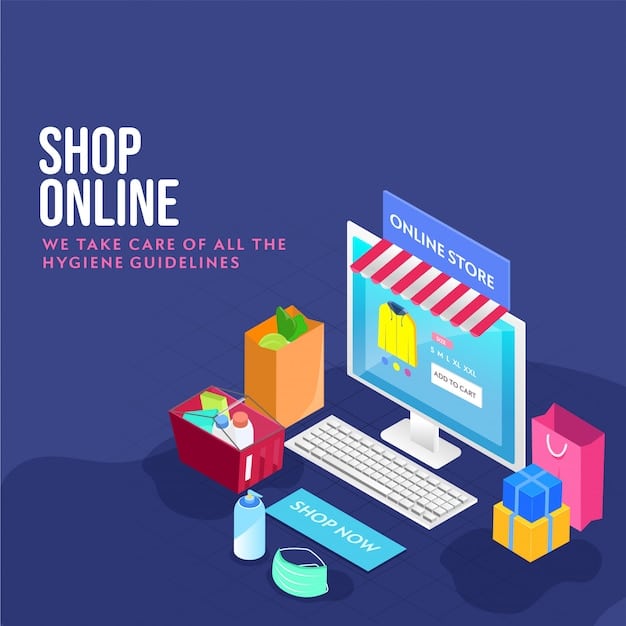E-commerce Conversion Rate Optimization: Boost Your Sales

E-commerce conversion rate optimization is the process of enhancing your online store to turn more visitors into paying customers by analyzing user behavior and implementing changes to streamline the buying process.
Turning website visitors into paying customers is the ultimate goal for any e-commerce business. E-commerce conversion rate optimization (CRO) is the key to unlocking this potential, focusing on strategies to maximize the percentage of users who complete a desired action, like making a purchase. Are you ready to learn how to implement effective CRO strategies and watch your sales soar?
Understanding E-commerce Conversion Rates
Before diving into optimization techniques, it’s crucial to understand what an e-commerce conversion rate is and why it’s important. This metric provides valuable insights into your website’s performance and the effectiveness of your marketing efforts.
What is a Conversion Rate?
A conversion rate is the percentage of website visitors who complete a desired action, such as making a purchase, subscribing to a newsletter, or filling out a form. In e-commerce, the most common conversion is a purchase, but other actions can also be considered conversions.
Why is it Important?
A good conversion rate indicates that your website is effective at guiding visitors towards making a purchase. Optimizing your conversion rate can lead to increased sales, higher revenue, and improved customer satisfaction without necessarily increasing website traffic. Analyzing the e-commerce conversion enables businesses to turn online retail into something successful for them.
By understanding and tracking your e-commerce conversion rate, you can identify areas for improvement and implement strategies that drive more sales. A low conversion rate might indicate issues with website design, pricing, or the checkout process.

Analyzing User Behavior to Identify Conversion Opportunities
To effectively optimize your e-commerce conversion rate, you need to understand how users interact with your website. Analyzing user behavior provides valuable insights into what works and what doesn’t, helping you pinpoint areas for improvement.
Website Analytics
Tools like Google Analytics provide a wealth of data about your website visitors, including their demographics, behavior, and the pages they visit. By tracking key metrics, you can gain a better understanding of how users navigate your site and where they encounter friction.
Heatmaps and Session Recordings
Heatmaps visualize where users click, move their mouse, and scroll on your website, highlighting areas of interest and potential usability issues. Session recordings capture user interactions, allowing you to see exactly how visitors navigate your site and identify pain points.
- Identify popular products and pages
- Understand user navigation patterns
- Uncover usability issues
- Optimize the checkout process.
By analyzing user behavior, you can identify specific areas on your website that are hindering conversions. This data-driven approach allows you to make informed decisions about how to optimize your site for better results.
Optimizing Product Pages for Higher Conversions
Product pages are crucial for driving conversions, as they provide potential customers with the information they need to make a purchase decision. Optimizing these pages can significantly impact your e-commerce conversion.
High-Quality Product Images
Use professional, high-resolution images that showcase your products from multiple angles. Allow users to zoom in to see details. Consider including videos that demonstrate the product in use.
Compelling Product Descriptions
Write clear, concise, and persuasive product descriptions that highlight the benefits and features of your products. Use keywords that your target audience is likely to search for.
Customer Reviews and Ratings
Display customer reviews and ratings prominently on your product pages. Positive reviews build trust and credibility, influencing purchase decisions.
Optimizing product pages involves providing potential customers with all the information they need to make a confident purchase decision. By focusing on high-quality visuals, compelling descriptions, and social proof, you can increase e-commerce conversion rates and drive more sales.

Streamlining the Checkout Process
A complicated or lengthy checkout process can lead to cart abandonment, so it’s essential to streamline this process and make it as easy as possible for customers to complete their purchase. This is a crucial aspect of e-commerce conversion process.
Reduce the Number of Steps
Minimize the number of steps required to complete a purchase. Remove unnecessary fields from the checkout form and consolidate steps where possible. One-page checkout options can significantly improve the user experience.
Offer Multiple Payment Options
Provide customers with a variety of payment options, including credit cards, PayPal, and other popular payment gateways. Offering more choices increases the likelihood that customers will find a convenient payment method.
Guest Checkout Option
Allow customers to make purchases without creating an account. Many users prefer not to create an account, especially for one-time purchases. A guest checkout option can reduce friction and encourage more conversions.
By streamlining the checkout process, you can reduce cart abandonment and increase the likelihood that customers will complete their purchases. Focus on minimizing steps, offering multiple payment options, and providing a guest checkout option to create a seamless and user-friendly experience.
Leveraging Social Proof to Build Trust
Social proof is a powerful tool for building trust and influencing purchase decisions. By showcasing positive feedback and testimonials, you can reassure potential customers that your products and services are reliable and trustworthy.
Customer Testimonials
Feature customer testimonials prominently on your website, especially on product pages and the homepage. Authentic testimonials can be incredibly persuasive.
Ratings and Reviews
Encourage customers to leave ratings and reviews for your products. Display these ratings and reviews prominently on product pages to build credibility.
Social Media Mentions
Showcase positive social media mentions and shares on your website. This demonstrates that your brand is valued and appreciated by customers.
- Display customer testimonials prominently.
- Encourage customers to leave ratings and reviews.
- Highlight social media mentions.
- Showcase awards and certifications.
By leveraging social proof, you can build trust and credibility with potential customers, increasing the likelihood that they will make a purchase. Focus on showcasing positive feedback, ratings, and social media mentions to reassure visitors that your products and services are reliable and valued.
Mobile Optimization for Conversions
With an increasing number of users shopping on mobile devices, it’s essential to optimize your e-commerce website for mobile conversions. A mobile-friendly website ensures a seamless shopping experience for all users.
Responsive Design
Use a responsive design that adapts to different screen sizes and devices. This ensures that your website looks and functions well on smartphones, tablets, and desktop computers.
Fast Loading Speed
Optimize your website’s loading speed to ensure a smooth and seamless mobile experience. Slow loading times can lead to high bounce rates and lost conversions.
Mobile-Friendly Navigation
Implement a mobile-friendly navigation menu that is easy to use and allows users to quickly find what they are looking for.
Mobile optimization is no longer optional; it’s a necessity for driving e-commerce conversions. By focusing on responsive design, fast loading speeds, and mobile-friendly navigation, you can ensure that your website provides a seamless shopping experience for all users, regardless of their device.
A/B Testing to Continuously Improve
A/B testing is a powerful method to continuously improve your e-commerce conversion rates. By testing different versions of your website, you can identify which changes lead to better results.
What is A/B Testing?
A/B testing involves creating two versions of a webpage or element, showing each version to a segment of your website traffic, and analyzing which version performs better. This data-driven approach allows you to make informed decisions about website improvements.
What to Test?
Test various elements of your website, including headlines, images, call-to-action buttons, and form fields. By testing different variations, you can identify which changes resonate best with your audience.
How to Implement A/B Testing?
Use A/B testing tools like Google Optimize, Optimizely, or VWO to set up and run your tests. These tools allow you to track key metrics and analyze the results to determine which version of your website performs better.
A/B testing is an indispensable tool for ongoing e-commerce conversion rate optimization. By systematically testing different elements and analyzing the results, you can continually refine your website to maximize conversions and drive more sales.
| Key Point | Brief Description |
|---|---|
| 🚀 Analyze User Behavior | Use analytics to understand how users navigate your site. |
| 📸 Optimize Product Pages | Improve images, descriptions, and customer reviews. |
| 🛒 Streamline Checkout | Reduce steps and offer multiple payment options. |
| 📱 Optimize for Mobile | Ensure a responsive design and fast loading times. |
Frequently Asked Questions (FAQ)
▼
A “good” e-commerce conversion rate typically falls between 2% and 5%. However, it can vary greatly depending on the industry, target audience, and the types of products or services offered.
▼
Improve loading speed through image optimization, using a content delivery network (CDN), minimizing HTTP requests, and leveraging browser caching. Regularly test your site’s speed with tools like Google PageSpeed Insights.
▼
Because a significant portion of online shopping occurs on smartphones. Mobile optimization ensures a seamless shopping experience, reducing bounce rates and increasing the likelihood of conversions from mobile users.
▼
A/B testing is a method of comparing two versions of a webpage to see which one performs better. It helps by identifying which elements or changes drive higher conversion rates, leading to data-backed design improvements.
▼
Customer reviews are highly important as they build trust and provide social proof. Positive reviews can significantly influence purchase decisions, while addressing negative feedback can improve customer satisfaction and loyalty.
Conclusion
Mastering e-commerce conversion rate optimization is an ongoing process that requires continuous analysis, testing, and refinement. By implementing the strategies outlined in this guide, you can turn more visitors into buyers and unlock the full potential of your online store, ensuring sustainable growth and success.





